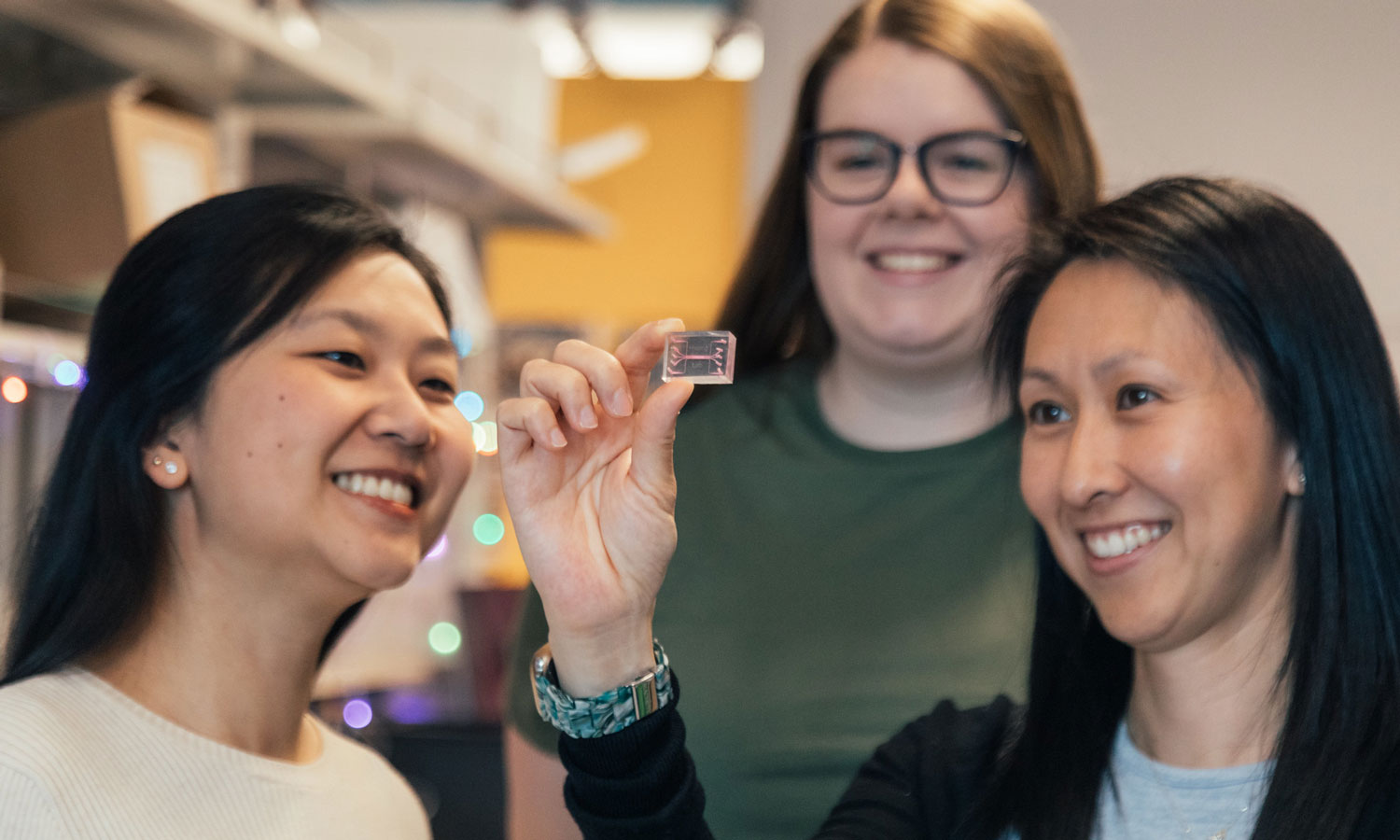Fueled by new National Cancer Institute grant, Priscilla Hwang, Ph.D., furthers study of cancer cell migration

Complimentary work that earned her a Faculty Early Development Award from the National Science Foundation, Hwang and her fellow researchers are examining cancer cell reactions that lead to metastasis.
Picture this: you see a large crowd of people, all moving together in the same direction. Maybe they’re headed into a sporting arena or getting ready to board a subway train.
Everyone in that crowd is a little different — in appearance, yes, but also in terms of how they act and react to the people crowded around them.
Each person is their own individual being; they communicate differently from one another and respond to their environmental surroundings differently. Some will move to the front of the crowd, leading everyone to a certain destination, while others will fall into more of a follower position.
How do these leaders communicate to the followers? How will different types of followers respond differently to the leaders guiding the way?
These are some of the questions leading the research of Priscilla Hwang Ph.D., assistant professor in the Department of Biomedical Engineering at the VCU College of Engineering, though instead of crowds of people, she is examining crowds of cancer cells.
Hwang is studying the microenvironments cancer cells live in and their migration to different parts of the body — also known as cancer metastasis. She began studying the topic in her postdoctoral research and has continued to explore it from different angles.
Currently, Hwang is partnering with principal investigators Gregory Longmore, M.D. and Amit Pathak, Ph.D. on a new phase of research fueled by a grant from the National Cancer Institute (NCI).
“This grant is really exciting because our previous work, which was published in Cancer Research and Developmental Cell, is the foundation by which this new grant is built upon,” says Hwang. “Receiving this grant shows how energized the community is about the direction our work is headed.”
Understanding Cancer Migration
When cancer metastasis occurs, it often means that a group of cancer cells is moving. When groups of cells are moving, there are many different types of cells that can be embodied in these clusters — just like in the crowd of people. Hwang and her partners’ research combines biomedical and mechanical engineering with molecular biology in hopes of developing a comprehensive understanding of how and why groups of cancer cells move together.
Early on in their research, Hwang and the team designed a “cancer-on-a-chip model,” a microfluidic model of breast cancer. They borrow electrical engineering concepts for the construction; first, the researchers draw out their blueprint and etch it on a silicon wafer in order to make a master mold. They can then take a silicon material to make a copy, or an inverse stamp of the print. They then insert breast cancer cells into this constructed environment and get different cells to move by adding different signals.
“From the first phase, we identified certain cells that can drive or initiate migration,” says Hwang. “Now, this new grant from the National Cancer Institute is focused on investigating what those actual pathways are that might be regulating the phenomenon that we’ve observed.”
When there are clusters of tumor cells moving together, there are many different types of cells wrapped up in the cluster, such as stromal helper cells or immune cells. Hwang and her fellow researchers want to understand how different signaling pathways in the various cells within the moving cluster work separately or together to contribute to metastasis.
“We believe that by understanding these reactions and relationships, we’ll have a better idea of what therapies might be more effective at targeting metastatic disease,” says Hwang.
Aside from skin cancer, breast cancer is the most common cancer in women in the United States, according to the American Cancer Society. The primary cause of breast cancer mortality is tumor metastasis, making Hwang’s research significant.
“Once a cancer has metastasized, it’s probably going to respond differently to therapies that are not specific for migration. That may be part of the reason why therapies are not as effective towards metastatic breast cancer. If we can understand the pathways of the events that are happening during metastasis, that may help us design targeted therapies that are going to treat this more effectively.”
National Cancer Institute Grant
The five-year grant from the National Cancer Institute was awarded in Spring 2022 and funding began in August 2022. Through the grant, Hwang, Pathek, and Longmore have been able to fund graduate students working in the lab; the first started during the Fall 2022 semester, helping Hwang with experiments and making the microfluidic platforms. There is also a group of students and faculty working on the Washington University side of the partnership.
Read more about the complimentary work of Hwang’s research here. For more information about VCU Biomedical Engineering, visit the program website.
Categories Biomedical Engineering, Research Grants